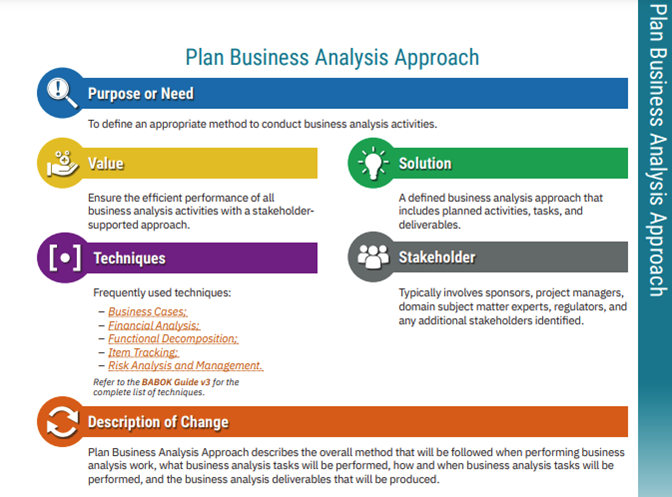Discover the Foundation for Effective Business Analysis
Receive free IIBA updates and exclusive content!
Business analysis helps organizations identify areas of improvement and opportunities for growth. By understanding the foundational concepts of business analysis, professionals can make informed decisions that will have a positive impact on the business’s profitability and overall success. Having a solid grasp of the foundation is essential and IIBA’s Business Analysis Standard provides that.

In a recent webinar, we discussed the top questions about IIBA’s Business Analysis Standard, and how to utilize this resource in your daily roles as business analysis professionals to drive better business outcomes.
Here are some Q&A's from the webinar:
1. What is The Business Analysis Standard?
The Business Analysis Standard is IIBA’s new publication that was published in November 2022 and was co-created with our global business analysis community. It provides a simplified, inclusive view of business analysis and includes the foundational concepts in a refreshed and easy-to-use format. The new Standard also provides the direction for the future development and integration of business analysis standards and resources.
2. Can you provide a summary of the key concepts covered in the Standard?
The Business Analysis Standard contains some existing key concepts and practices from the BABOK® Guide, but also from the Agile Extension to the BABOK® Guide. What hasn’t changed is how we define business analysis. This also includes how we perform business analysis and why the business analysis is important. We also retained The Business Analysis Core Concept Model™, or the BACCM™, Knowledge Areas and business analysis tasks, which are an important part of The Business Analysis Standard.
3. Can you explain how this publication relates or differs from the previous Global Business Analysis Core Standard?
The BABOK Guide v3 was published in 2015, and our community asked for a summarized version of it. The Global Business Analysis Core Standard was published in 2017 and it was a summarized version of the BABOK Guide in every sense. Compared to v3, it was light, with around 40 pages of content.
With the new Business Analysis Standard, IIBA took a different approach. Instead of just summarizing the existing content, we asked the community for their insights. Professionals in various roles in different industries around the world participated in the development of the new Standard. We engaged volunteers worldwide for a series of workshops, during which they shared their thoughts and helped us set the direction for the new Standard.
We also engaged global business analysis experts from different industries to participate in, what we called, the expert review, and their feedback was incorporated into the Standard. Finally, we also had a public review process during which IIBA’s Members had an opportunity to review the Standard and send us their feedback.
The new Business Analysis Standard represents the most current and most important thinking from our global business analysis community. It is not an update; it completely replaces the current Global Business Analysis Core Standard.
4. What new information is available in The Business Analysis Standard?
The Business Analysis Standard contains some new concepts as well. They include:
- Flexible, adaptable mindset that is required for effective business analysis
- Important principles for effective mindset
- Foundational competencies and foundational techniques that were identified by our community as the most important competencies and techniques that every business analysis professional should learn and develop, and that could be applied to and used on many different types of initiatives
- Organizational considerations such as sustainability, diversity, equity, and inclusivity
- Managing the delivery of business analysis within an organization in different ways, such as Centre of Excellence or Community of Practice .
5. How does this publication help professionals understand and apply key business analysis concepts?
The Business Analysis Standard summarizes concepts and proven practices that represent the foundation for good analysis. With this Standard, we are moving away from hard-to-read books. Instead, the new Standard is lightweight and explains business analysis in a simplified and easy-to-use way.
It is designed for ease of use and provides some basic examples of how business analysis tasks apply to numerous business contexts and across all types of initiatives, which could help business analysis professionals perform business analysis. It also includes links to other knowledge sources to help business analysis professionals perform better business analysis.
6. How can you best leverage this publication as a practitioner?
As a practitioner, you can use The Business Analysis Standard as a foundation for understanding business analysis and what good business analysis looks like. Key business analysis concepts and practices are described in the Standard.
You can also use the Standard as a guide for performing business analysis to produce better business results. The Standard identifies foundational techniques that are essential to performing business analysis. It also identifies techniques that can be used when performing each business analysis task.
The Standard represents a simplified, comprehensive view of business analysis, but it also provides a pathway to other knowledge sources, which makes it easier for you, as a practitioner, to find more detailed and relevant information.
You could also use the Standard for your professional development. The Standard identifies foundational competencies that are fundamental to performing business analysis. So, it can help you identify competencies that you could improve or further develop. And finally, as a practitioner, you can use the Standard to explain the importance of business analysis work to those who may not understand it.
7. What’s the best way to use this resource as a business leader or manager?
When we say a business leader or manager, this could, for example, include the Community of Practice leader or business analysis Center of Excellence leader. Leaders are usually most concerned about improving their team and delivering more to their organization. So, as a leader, you could use the Standard to benchmark current performance and to identify the areas to improve.
You can also use the Standard to establish and share a common understanding of good business analysis practices, processes, standards, methodologies, and techniques across the organization. Leaders could use the Standard as a starter kit to assess and improve their teams’ capabilities in order to deliver higher-quality outcomes.
Also, you can use the Standard to help other leaders in the organization understand the value that good business analysis can deliver and communicate the value created by the business analysis team.
8. How does the Standard address the current challenges faced by business analysis professionals?
The world around us is constantly changing and evolving. And so is business analysis. Therefore, business analysis professionals need to keep up with the latest trends and best practices and be able to adapt faster to changing needs. We are also surrounded by large amounts of data. As businesses generate more and more data, it can be difficult for business analysis professionals to identify the most relevant information and make sense of it.
IIBA realized that we need to help business professionals by providing them relevant, simplified, and easy-to-use information. The Standard is our first step towards that goal. The Standard represents the foundation for effective business analysis. It is up-to-date and aligned with evolving business practices. The Standard provides a summary of everything that is essential to every business analysis professional and includes references to other relevant knowledge sources.
9. Can you explain the new task cards feature?
As you already know, the Business Analysis Standard describes the 30 business analysis tasks. However, we repurposed them by creating them as one-page overview cards. These cards are color-coded and aligned to the business analysis core concept model.
Each business analysis task is described by having in mind:
- The need or the purpose of the task
- The value that the task creates
- The solution, which is the output or the outcome of the task
- Stakeholders that are typically involved in the task
- Techniques that are frequently used in the context
- Change that is created by performing the task
We also provided a small example for each of the tasks. Those are basic examples of how business analysis tasks apply to different business contexts and across all types of initiatives. These are not detailed examples but represent the first step in a new direction and include links to other relevant knowledge sources.
These task cards summarize everything fundamental you need to know about a certain task. You can print them out separately and use them whenever you need them. For example, you can use them as a quick reference when planning your business analysis activities.
Source: The Business Analysis Standard
10. How does The Business Analysis Standard relate to BABOK® Guide?
The Business Analysis Standard is meant to be a summarized representation of concepts and practices that are essential to creating good business outcomes. Some of these concepts and practices, like the Business Analysis Core Concept Model, Knowledge Areas, and business analysis tasks, can also be found in the BABOK Guide v3. At this moment, there are no changes to the BABOK Guide v3. However, in the future, The Business Analysis Standard will drive the future updates of the BABOK Guide content.
11. Does The Business Analysis Standard affect other guides from IIBA? If so, how?
Right now, we have different guides which are not connected. The Business Analysis Standard is the first step toward connecting all our knowledge sources to help business analysis professionals perform better business analysis. It provides key concepts from different knowledge sources but also links to other sources, such as the BABOK Guide, The Guide to Product Ownership Analysis, The Guide to Business Data Analytics, and the Agile Extension to the BABOK Guide, where you can find more detailed information on specific topics. These links could be considered as our first step towards integrated knowledge sources.
At this point, the Standard does not affect the content of our guides. However, in the future, the Business Analysis Standard will drive future updates, not just of the BABOK Guide but of our other guides as well.
12. Are there any plans for future updates or new editions of the Standard?
Yes. The Standard will be updated regularly to align with the changes and needs of our community. So, you could expect more frequent updates that are relevant to the community’s needs. As a matter of fact, we have already started working on our next update.
13. Does The Business Analysis Standard affect IIBA Certifications?
No, at this point, current certifications or course materials are not affected by the new Standard. However, in the future, as we update the Standard, there may be updates to our core certifications. But, you don’t need to worry, any changes will be communicated with ample time.
To watch the full webinar on-demand visit IIBA’s YouTube page.
Get your Free Copy
The Business Analysis Standard is available free to the entire business analysis community. Download your copy today at iiba.org/TheStandard.
About The Author:

Maja is an experienced business analysis professional, consultant, and trainer dedicated to the continuous promotion of business analysis as a profession. As a consultant and trainer, she has helped many organizations develop a Centre of Excellence, establish business analysis standards, and improve the quality of business analysis activities. In her current role as Product Manager for IIBA, she develops compelling and high-value business analysis content in support of IIBA’s strategic efforts.




